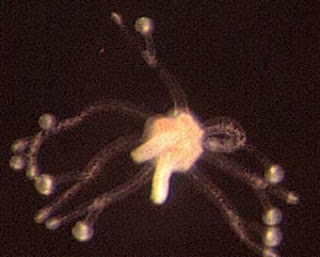Scientists have created a jellyfish with twelve heads in a lab at Hanover University of Veterinary Medicine in Germany. Bernd Schierwater and colleague Wolfgang Jakob (or "God" as they like to collectively call themselves) claim to have created the freakish monstrosity to study how colonies of multiheaded organisms develop in nature. By manipulating certain Cnox genes, a specific kind of gene which helps control how the bodies of jellyfish embryos form, Schierwater and Jakob caused the embryo to develop in strange ways. Simply by inhibiting the Cnox-2 gene, up to twelve heads would form. The jellyfish they used is called a European hydromedusa (Eleutheria dichotoma) and can be found in the waters off of France.
This mutant jelly only has two heads.
Jellyfish are very similar to certain kinds of coral, which display many-headedness naturally. Schierwater believes that perhaps somewhere down the evolutionary chain a common ancestor of both jellyfish and coral might have had certain Cnox genes inhibited causing to to grow many heads, and eventually lead to the coral reefs which now exist in every ocean on the Earth.
When asked what the chances were the that twelve-headed jellyfish would break out of its enclosure and go on a muderous rampage, before finally being frozen by NATO forces and then shattered into a million tiny shards, Schierwater put the chances at around "50-50."
Not all genetically modified critters are unpleasing to the human eye...